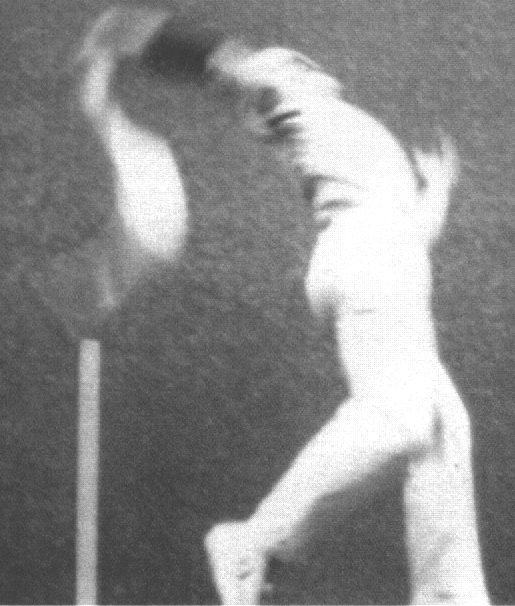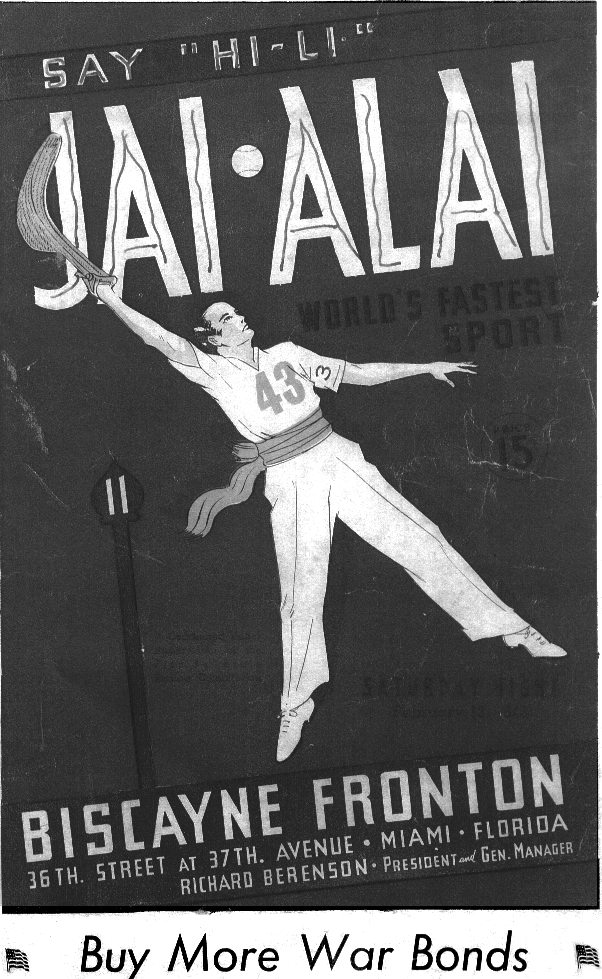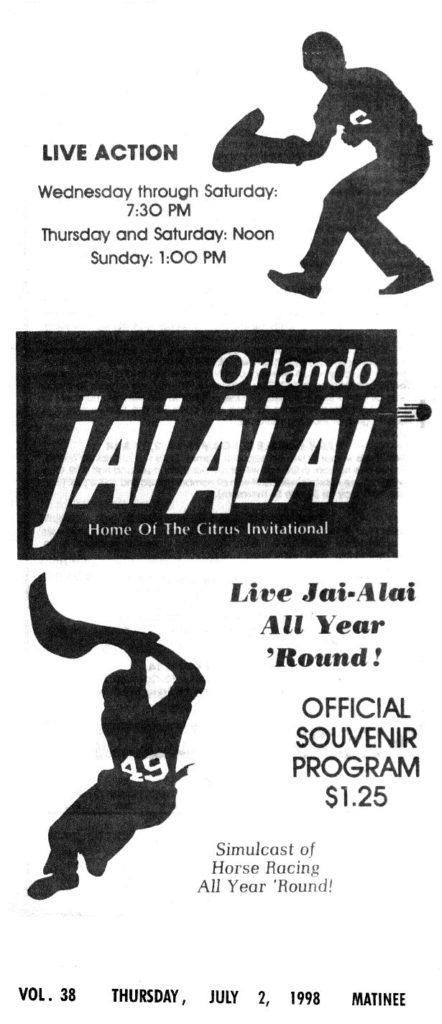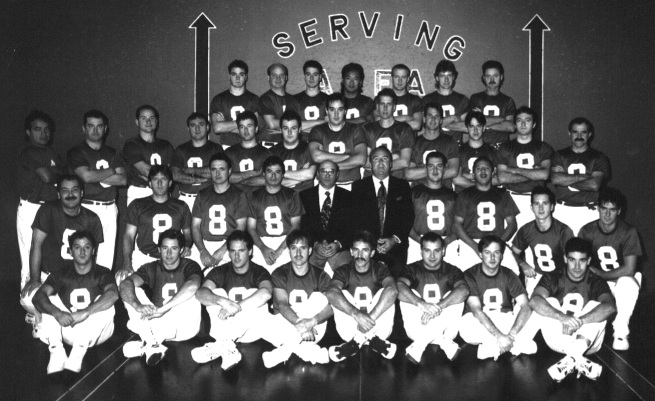Jai Velocity

Imagine a ball travelling at over 300 km/h, and capable of shattering bullet-proof glass. Imagine facing it, with no real protection apart from a helmet. Imagine, in fact, trying to catch this ball in a wicker basket, and throw it back where it came from. Welcome to the world of jai-alai, the world’s fastest ball game.
And not just the fastest – it may be one of the oldest too, as jai-alai’s origins certainly date back to Greek times (where it was called ‘pilos’) and possibly even earlier. However, it was the Basques, inhabitants of the border region between France and Spain, who took the basics of a game played against church walls, and developed it into something best described as ‘squash with attitude’. The game has since been taken around the world to wherever Basques live, particularly Central America and South East Asia.
Initially played with bare hands, the original has evolved into many different versions, of which jai-alai is the most merciless. The defining moment in jai-alai’s history was in 1857, when a 14-year old French Basque boy, rejoicing in the name of Gantchiki Dithurbide, couldn’t afford the glove with which the game was played at the time. Instead, he borrowed a basket from his mother’s kitchen and, just like William Webb Ellis, discovered a whole new ballgame. Nowadays, the basket is custom-made, and strapped to the player’s wrist, but the general principle remains the same: capture and return the ball (called a ‘pelota’) off the front wall, ideally in such a way that your opponent can’t reach it before it bounces twice or goes out of play.
It’s that vocabulary thing again…
- cancha The court on which jai-alai takes place.
- cesta Spanish for “basket”, the curved throwing and catching instrument in jai-alai. Each is individually made for a player, depending on their specific needs and preferences. It is made from chestnut wood and reeds, both imported from Spain.
- contracancha The wooden, foul area of the court down the right-hand side. Out-of-bounds if the pelota lands on it, but a player can catch and throw a ball from this area without penalty.
- frontis The front playing wall; the punishment it takes can be seen from the fact that it’s made of granite blocks set in concrete…
- fronton The building in which the sport is played.
- jai-alai The game itself: in the Basque language, it means “merry festival” (“Jai” is festival; “Alai” means joyous). Pronounced ‘HI-a-LYE’.
- juez Each of the three judges, who wear striped shirts, present during the games to make close calls.
- lateral The side wall of the playing court on the left, opposite the contracancha.
- pelota Spanish for “ball”. Handmade: virgin rubber wrapped in nylon thread and sewn into two goatskin covers.
- pelotari A jai-alai player.
The pelota behaves like one of those super-balls you get in toy shops, so delivering and reading the ricochets and spin are crucial tests of your abilities. You must be able to come up with shots from all angles, and it’s common to see players hurling themselves to the floor, in order to take advantage of the ball’s speed as it passes over them, whipping it forward with additional momentum. There’s not a lot of room for error when you’re catching a 6 cm. pelota, travelling at lightning speed, in a basket maybe 8 cm. wide. And as if this wasn’t hard enough, to make things even trickier, the ball has to be returned immediately.

The game was first introduced to the United States in 1904, at the St.Louis World Fair; nowadays, Florida is the main area, with frontons in several cities, though the heart of jai-alai remains in France and Spain, and the sport was played at the Barcelona Olympics in 1992. At the professional level in America, it exists largely as a focus for betting. Games are played between eight players, or teams in the case of doubles play; however, partners in the latter are perpetually switched around, for variety and to keep things balanced. A range of bets are on offer, allowing you to lose money in a number of interesting ways when your selections don’t perform. It’s “winner stays on”, with the loser of each rally going to the back of the queue, to await their next turn; the first to reach seven or nine points wins, with the scores of the others at that stage determining their positions. This makes for exciting games; the format means that a player can be on the verge of victory, only to have it snatched away by a single unlucky bounce. He is then forced to sit on the bench and watch while his rivals’ scores creep up…
Inevitably it is “his”; no woman has ever played the game at the highest standard. This is an unfailingly macho pastime, as can be seen by the limited protection worn by the players. Helmets were only introduced in the late 60’s and before then, fatalities due to head injuries were not uncommon. This is unsurprising when you consider that the pelota weighs only a little less than a cricket ball, yet can travel twice as fast as the most venomous bouncer. Nor is it a sport for left-handers; even they must use their right hands, because of the lop-sided design of the court. It is a young man’s game, with players in their mid-thirties being regarded as veterans – at the other end of the scale the youngest professional player was a mere nine years old when he made his debut in 1922. This makes Tiger Woods look positively geriatric.

Rallies are generally relatively short, especially in singles play, partly because of the speed of the ball – the record, set in 1979, stands at 301 km/h – partly because the playing area is big. There are no fixed sizes, and the dimensions of the cancha vary depending on the skill of the players, but at the top level, they can be sixty metres long, and usually around ten metres high and wide. Only one side wall is in play; the right hand side is out-of-bounds, and is replaced with glass or chain-mesh in order to give spectators a good view.
And it’s an ideal game to watch, because its basics are simple. Even after a few games, you begin to grasp the tactics, which are somewhat similar to those of squash: keep the ball as close to the side and the back as you can. In doubles play, one player takes the front and the other the rear of the court – just as in tennis, where you can dictate play if you’re at the net, so in jai-alai the players try to keep the ball out of the opposing front man’s reach.
Yet it is also infinitely subtle in its intricacies. For example, each pelota has individual characteristics, and they vary with time; one which has been played with recently will bounce more than a ‘cold’ ball. The player serving has the choice, but must offer it to the receiver, who can reject a torn or damaged pelota. This inspection gives them an idea of how lively it is, and in doubles play, a system of hand signals are used to communicate this vital information between the receiver and his partner.
Ernest Hemingway was entirely right to describe jai-alai as “constant excitement and manly effort taken to the utmost limits…fast, attractive and joyful”. He’s not the only celebrity fan; baseball legend Babe Ruth used to be an enthusiastic player, as was Paul Newman, while people from Art Garfunkel through Gene Hackman to Riddick Bowe have been seen enjoying games. It certainly is a change from theme-park queues: the princely sum of $1 buys general admission at the Orlando fronton, a remarkably cheap way to spend an afternoon in air-conditioned comfort, with beer and snacks available as well. Unlike some gambling pursuits, it’s not even necessary to bet to enjoy yourself: it’s fun simply to watch the games, and marvel at the skill and athletic ability of the players in one of the most memorable of sports.
Orlando Jai Alai, 6405 S.Highway 17-92 at S.R.436, Fern Park, FL 32730. (407) 339-6221
WWW: http://gentech.net/orlando-jaialai/index.htm
An interview with Tracy Moore, professional jai-alai player
Tracy Moore was born and raised in Miami, Florida. Now aged 36, he has been playing Jai-alai since he was 12, and professionally since he was 18.
What attracted you to Jai-alai?
My father used to own an amateur Jai-alai fronton. When he was in school, he was introduced to Jai-alai by a schoolmate and fell in love with the game. They made their own equipment and used to go behind a movie theatre to play every day. They were thrown out of there several times and eventually built their own court. My father allowed others to use it and the North Miami Amateur Jai-alai fronton was born. It was very successful and I was exposed to Jai-alai there. I played everyday as a child and eventually decided to make this my career. I have been playing professionally for 18 years now.
How are Jai-alai players picked?
By scouts. The scouts are sent to Spain, Mexico and France. I happened to be playing at the time in Tijuana, Mexico in the minors and was discovered by Santi, the player manager for the team in Orlando. He asked me to play with Orlando and I have been playing there ever since.
Is playing outside the country different than playing here?
Basically not. In Mexico, the game is the same and the betting is the same style. The only difference is in Spain and France. At their Jai-alai, the games are played with 35 point, two team plays instead of single 7 point games. These last much longer and the servers are sometimes asked to wait so that more betting can take place. The rules, the equipment and the uniform are exactly the same. Tradition states that a red sash must be worn – it’s the same one as worn during the running of the bulls in Spain – and that players must “march out” and salute the crowd to show respect.
What’s the most important event for Jai-alai players?
The Jai-alai World Championship, which is hosted every year in either Spain or France – it is very much like Wimbledon. The ten best players play in a round-robin until eventually the #1 plays the #2. Generally all the players in these games are from Spain and/or France. There are also Amateur World Championship games where players come from all over the world including the Phillippines, Cuba, China, etc.
Who is, in your opinion, the best player?
Well, as far as people in my generation are concerned, I feel that a player named Bolivar from Spain is the greatest. But he is now retired. The best player now is a Miami player from France named Michelaina.
The sport looks very hard on the arm muscles. Are injuries common?
The most common serious injury is in the shoulder where the bicep muscle drops. There are also lots of back injuries. We keep a full time trainer who is always helping us maintain ourselves and aids us with icing down after each game, massages, etc. I am lucky that in 18 years I have not had an injury serious enough to end my career. Some guys aren’t so lucky.

Since you are an American, are you treated differently? Do you ever feel like an outsider?
No. Language is not a problem since my wife is Mexican and I speak Spanish, though not fluently. I have never had any problems with other players, since they come over here very enthusiastic and eager to learn English, in order to meet girls!
How is the game organised in Florida?
Players are contracted for one year. Other frontons will make offers if they want you, or you are free to contact them yourself. The best part about working here in Orlando is that this particular fronton is year round. The only other year round fronton in the US is in Miami. The rest are seasonal so the players are limited. Although Jai-alai is an excellent sport, I am not thrilled that is basically a betting sport – I would like to see it as a normal sport, but since it is a betting sport, it derives most of its income from the gambling. Jai-alai business is a little slow now, ever since the institution of legalized gambling on Indian reservations in Florida, and the re-instatement of the State Lottery, as well as casino boats that sail out into the Atlantic. Because gambling was limited in Florida at one time to the horsetracks, dog tracks and Jai-alai, the frontons used to be constantly sold out. Now it is much easier to get in to see the games and they even allow families to bring their children to watch.
How do you feel about people betting on you?
I really don’t think about it. I think the only thing that affects me about the betting is that it is a motivating factor in my play.
Does it bother you when spectators heckle or scream?
Not really. The spectators do it all the time. We are professional and realize that if we show them it bothers us, they will do it more. So we basically ignore it.
How do players get paid?
We receive a base salary plus bonuses. If we come in first, second or third we will get extra bonuses, coming in first, of course being the highest, and we receive a bonus for actually playing a game. It motivates us to play better. Also, because of the fact that there are so many players out there who want to play professionally, we know that for each one of us, there are at least five out there who want our job. It’s another motivational factor!
Why do you play under the name ‘Bob’?
Bob is actually my middle name. My first name is Tracy and my middle name is Robert. The manager at the fronton knew my father and they always called him Bob. It is a tradition that if you come from a line of Jai-alai players, you would use your father’s name. So they used my father’s name on the roster for me.
Do you have plans for the future after Jai-alai?
I would like to play until I am at least forty. Then after that? Well, I’ll cross that bridge when I come to it…